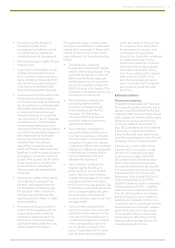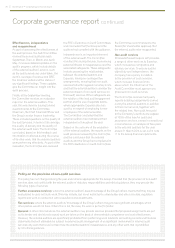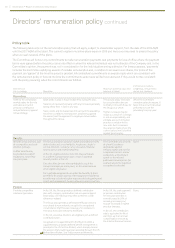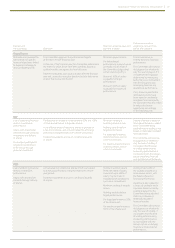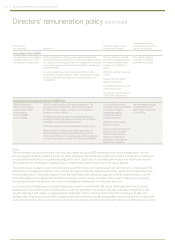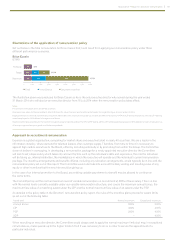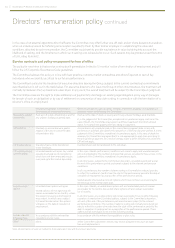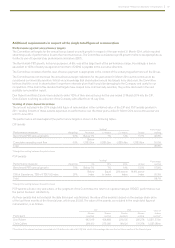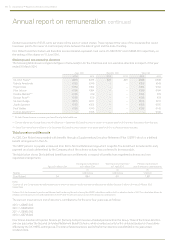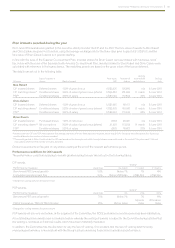Experian 2014 Annual Report Download - page 84
Download and view the complete annual report
Please find page 84 of the 2014 Experian annual report below. You can navigate through the pages in the report by either clicking on the pages listed below, or by using the keyword search tool below to find specific information within the annual report.
80 Governance • Report on directors’ remuneration
Directors’ remuneration policy continued
Policy table
The following table sets out the remuneration policy that will apply, subject to shareholder support, from the date of the 2014 AGM
until the 2017 AGM at the latest. The current long-term incentive plans expire in 2016 and hence we may need to amend the policy
when we seek renewal of the plans.
The Committee will honour any commitments to make remuneration payments and payments for loss of office where the payment
terms were agreed before the policy came into effect or when the relevant individual was not a director of the Company and, in the
Committee’s opinion, the payment was not in consideration for the individual becoming a director. For these purposes, ‘payments’
includes the Committee satisfying awards of variable remuneration and, in relation to an award over shares, the terms of the
payment are ‘agreed’ at the time the award is granted. All contractual commitments or awards made which are consistent with
the remuneration policy in force at the time the commitments were made will be honoured even if they would not be consistent
with the policy prevailing when the commitments are fulfilled.
Element and
link to strategy Operation
Maximum potential value and
payment at target
Performance metrics,
weightings, relevant time
period and clawback
Base salary
Reflects the competitive
market salary for the role
and takes account of
personal contribution
and performance against
Group strategy.
Base salary is paid in equal instalments during the year.
Salaries are reviewed annually, with any increases generally
taking effect from 1 April in any year.
Salary levels and increases take into account the prevailing
economic conditions, best practice, positioning against
the market and the approach to employee remuneration
throughout the Group.
The annual salary increases
for executive directors are
normally in line with those for
the Group as a whole.
Higher increases may be
made as a result of a change
in role or responsibility, and
will take account of market
practice in relation to the
new role. Such increases
may also be made where the
current salary level is behind
market benchmarks.
When the Committee
considers salary increases, it
takes into account individual
performance over the
preceding financial year.
Benefits
Benefits are provided as part
of a competitive and cost-
effective package.
Further benefits may
be provided to support
expatriates, where they
have relocated.
The Group provides a range of market-competitive benefits
that includes, but is not limited to, healthcare, death in
service provision, company car or allowance, financial
and tax advice and membership fees.
In the US, eligible executive directors may participate
in a deferred compensation plan, which is standard
market practice in the US.
Executive directors can also participate in any of the
Group’s all-employee share plans, on the same basis as
other eligible employees.
For expatriate assignments, we retain the flexibility to tailor
benefits to the circumstances of the assignment. Additional
benefits may include relocation expenses at the beginning and
end of each assignment, housing allowance and school fees.
The Committee sets benefits
at a level it considers
appropriate against
relevant market practice for
comparable roles in similar
companies, and sufficient
based on the role and
particular circumstances (for
example where the individual
is required to relocate).
None.
Pension
Provides competitive
retirement provision.
In the UK, the Group operates a defined contribution
plan with company contributions set as a percentage of
base salary. An individual may elect to receive a cash
allowance instead.
The Group also operates a defined benefit plan which is
now closed to new entrants, except in the exceptional
circumstance that this was necessary, for example, to
recruit an executive director to the Board.
In the US, executive directors are eligible to join a defined
contribution plan.
As agreed on his appointment to the Board in 2006, a
supplementary unfunded defined benefit arrangement is
provided in the US for Don Robert, which broadly mirrors
the pension that would have been provided through the UK
defined benefit plan. See Total pension entitlements.
In the UK, the cash payment
or pension contribution
for executive directors is
normally equal to 20% of
annual gross salary but
may be increased if market
practice changes.
In the US, the contribution
rate is equivalent to 4% of
earnings, up to an annual
compensation limit set by
the Internal Revenue Service.
None.
P88







